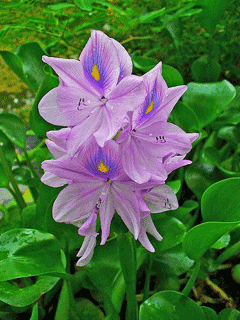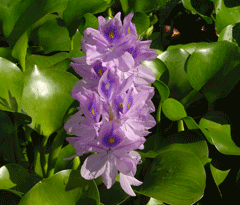 |
|
http://commons.wikimedia.org/wiki/User:Llez |
 |
|
Translate this page:
Summary
Bloom Color: Blue, Lavender.
Main Bloom Time: Early summer, Late summer, Mid summer. Form: Spreading or horizontal.
Physical Characteristics

 Eichhornia_crassipes is a PERENNIAL growing to 0.3 m (1ft) at a fast rate. It is in flower from May to September. The species is hermaphrodite (has both male and female organs).
Eichhornia_crassipes is a PERENNIAL growing to 0.3 m (1ft) at a fast rate. It is in flower from May to September. The species is hermaphrodite (has both male and female organs).
It can fix Nitrogen.
Suitable for: light (sandy), medium (loamy) and heavy (clay) soils. Suitable pH: mildly acid, neutral and basic (mildly alkaline) soils. It can grow in semi-shade (light woodland) or no shade. It prefers moist soil.
UK Hardiness Map
US Hardiness Map
Synonyms
E. speciosa.
Plant Habitats
Edible Uses
Young leaves and petioles - cooked[144, 177, 272]. Virtually tasteless[144, 177]. Said to be used as a carotene-rich table vegetable in Formosa. Javanese sometimes cook and eat the green parts and inflorescence[269]. Flower spikes - cooked[144, 177].
References More on Edible Uses
Medicinal Uses
Plants For A Future can not take any responsibility for any adverse effects from the use of plants. Always seek advice from a professional before using a plant medicinally.
None known
References More on Medicinal Uses
The Bookshop: Edible Plant Books
Our Latest books on Perennial Plants For Food Forests and Permaculture Gardens in paperback or digital formats.

Edible Tropical Plants
Food Forest Plants for Hotter Conditions: 250+ Plants For Tropical Food Forests & Permaculture Gardens.
More

Edible Temperate Plants
Plants for Your Food Forest: 500 Plants for Temperate Food Forests & Permaculture Gardens.
More

More Books
PFAF have eight books available in paperback and digital formats. Browse the shop for more information.
Shop Now
Other Uses
Water hyacinths are potentially an excellent source of biomass. Through an anaerobic fermentation process, polluted hyacinths can be converted to the natural gas methane - a costly process that may become more economical as supplies of underground natural gas are depleted[269]. Dried and cleansed plants can be used as fertilizer and plant mulch[144, 269]. Eventually, living aquatic plants might serve aboard long-distance manned spacecraft, absorbing wastes and converting carbon dioxide to oxygen, then being themselves converted into food[269]. The plant can be cultivated for use in wastewater treatment, and can be incorporated into a system where the biomass is harvested for fuel production[269]. Since this biomass is a by-product of wastewater treatment, it has a positive environmental impact, and thus poses no threat as competitor to food, feed, or fibre-producing plants[269]. Wilted water hyacinth, mixed with earth, cow dung, and woodashes in the Chinese compost fashion, can yield useful compost in just two months[269]. Although potential yields are incredible, so are the costs of removal or attempted eradication of this water weed. Standing crops have been estimated to produce 100-120 tonnes per hectare per year[269].. Under ideal conditions, each plant can produce 248 offspring in 90 days[269]. Water hyacinth roots naturally absorb pollutants, including such toxic chemicals as lead, mercury, and strontium 90 (as well as some organic compounds believed to be carcinogenic) in concentrations 10,000 times that in the surrounding water[269]. In Africa, fresh plants are used as cushions in canoes and to plug holes in charcoal sacks[269].
Special Uses
References More on Other Uses
Cultivation details
Landscape Uses:Container. 240, 200 Prefers growing in a sunny but cool pool[260]. Water Hyacinth is reported to tolerate an annual precipitation of 82 to 270cm, an annual temperature range of 21.1 to 27.2°C and an estimated pH in the range of 5.0 to 7.5[269]. The leaves are killed by frost, and plants cannot tolerate water temperatures in excess of 34°C[269]. This species is not very cold-hardy, tolerating temperatures down to about 0°c[260]. It requires greenhouse protection over winter in Britain[1]. Plants can be grown outdoors in the warmer parts of the year and then be potted up in moist compost during long spells of cold weather[260]. A very invasive weed of water courses in the tropics[260], causing great environmental problems in many areas where it has become naturalized. Subsistence farmers in Bangladesh face disaster when rafts of water hyacinth weighing up to 300 tonnes per hectare float over their rice paddies. As the floods recede, the weeds remain on the germinating rice, thus killing it[269]. Engineers have estimated that the Panama Canal would be impassable within three years without continuous aquatic weed control measures[269]. Azotobacter chroococcum, a Nitrogen-fixing bacteria, may be concentrated around the bases of the petioles but doesn't fix Nitrogen unless the plant is suffering extreme Nitrogen-deficiency[269]. Special Features:Not North American native, Invasive, Wetlands plant.
References Carbon Farming Information and Carbon Sequestration Information
Temperature Converter
Type a value in the Celsius field to convert the value to Fahrenheit:
Fahrenheit:
The PFAF Bookshop
Plants For A Future have a number of books available in paperback and digital form. Book titles include Edible Plants, Edible Perennials, Edible Trees,Edible Shrubs, Woodland Gardening, and Temperate Food Forest Plants. Our new book is Food Forest Plants For Hotter Conditions (Tropical and Sub-Tropical).
Shop Now
Plant Propagation
Seed - Seeds can tolerate submersion or desiccation for 15 years and still germinate[269]. Scarification, but not light, may be required for germination[269].
Other Names
If available other names are mentioned here
Native Range
SOUTHERN AMERICA: French Guiana, Guyana, Suriname, Venezuela, Brazil (northeast)
Weed Potential
Right plant wrong place. We are currently updating this section.
Please note that a plant may be invasive in one area but may not in your area so it's worth checking.
Conservation Status
IUCN Red List of Threatened Plants Status :

Growth: S = slow M = medium F = fast. Soil: L = light (sandy) M = medium H = heavy (clay). pH: A = acid N = neutral B = basic (alkaline). Shade: F = full shade S = semi-shade N = no shade. Moisture: D = dry M = Moist We = wet Wa = water.
Now available:
Food Forest Plants for Mediterranean Conditions
350+ Perennial Plants For Mediterranean and Drier Food Forests and Permaculture Gardens.
[Paperback and eBook]
This is the third in Plants For A Future's series of plant guides for food forests tailored to
specific climate zones. Following volumes on temperate and tropical ecosystems, this book focuses
on species suited to Mediterranean conditions—regions with hot, dry summers and cool, wet winters,
often facing the added challenge of climate change.
Read More
Expert comment
Author
(C.Mart.)Solms.
Botanical References
50200270
Links / References
For a list of references used on this page please go here
Readers comment